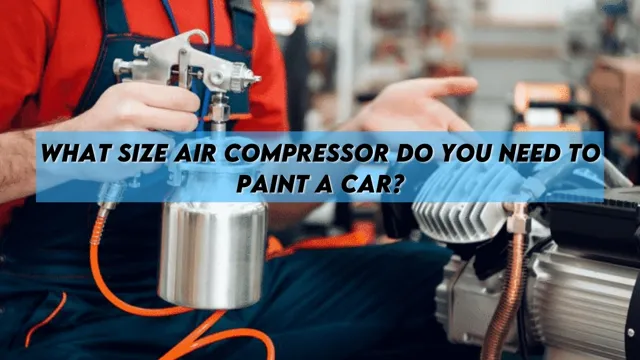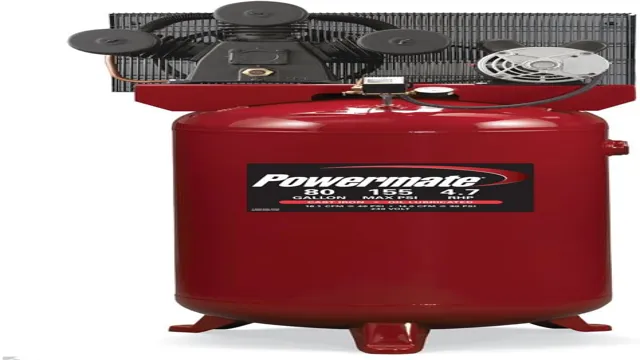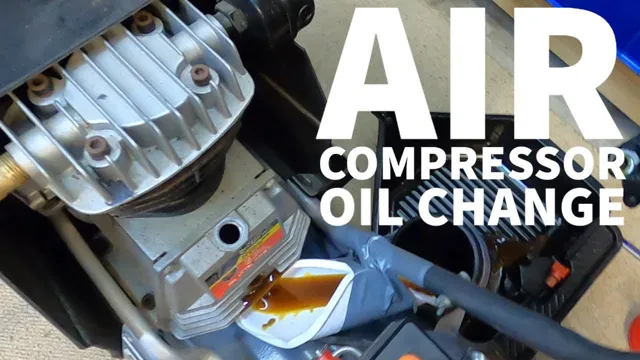What Air Compressor Do I Need to Paint a Car? A Complete Guide

Painting your car is an exciting and personal project that requires precision, patience, and the right tools. One of the most critical considerations you need to make is choosing the right air compressor. An air compressor is an essential tool for an effective and efficient automotive paint job.
It powers the paint sprayer and helps in achieving a smooth and flawless finish. With various models and types available in the market, choosing the right air compressor for car painting can be challenging. The wrong choice can negatively impact the finish, cause overspray, or damage the paint job.
Therefore, it is crucial to understand the factors to consider when selecting an air compressor to get the job done right. This blog post will provide you with valuable insights to help you choose the right air compressor for painting your car. From the air compressor types, flow rate, tank capacity, and power requirements, this post will equip you with the knowledge you need to make the best decision.
So, sit tight and read through to learn everything you need to know about choosing the right air compressor for painting a car.
What is an air compressor?
If you’re planning to paint a car, then you need to know what kind of air compressor is necessary to get the job done. An air compressor is a machine that converts power into compressed air by compressing and storing air in a tank. For painting a car, you’ll need a compressor that can deliver consistent and steady airflow for extended periods.
Typically, a compressor with a tank size of at least 30 gallons will suffice for most automotive painting applications. You’ll also need to consider the CFM (cubic feet per minute) rating of your air compressor. For painting a car, you’ll need an air compressor with a rating of at least 7-8 CFM at 90 PSI.
This will give you the consistent airflow you need for an even coat of paint. Overall, choosing the right air compressor for painting a car can make a significant difference in the quality and efficiency of your work.
Explanation of air compressors and their uses
An air compressor is a machine that converts power into energy stored as pressurized air. This compressed air has a variety of uses across a range of industries. Some common applications of air compressors include powering pneumatic tools and machinery, inflating tires and other inflatable objects, HVAC control systems, and spray painting.
The power source used to operate an air compressor can vary from gas engines to electric motors depending on the size, need, and portability of the machine. One of the most significant advantages of air compressors is their versatility in powering a wide range of tools with minimal maintenance. A carefully selected air compressor can save time, increase productivity, reduce costs, and is a must-have tool for any industrial setup.

Factors to Consider for Painting a Car with an Air Compressor
If you’re planning on painting your car with an air compressor, there are several factors to consider. First and foremost, you need to make sure you have the right type of air compressor. It’s recommended to use a compressor with a minimum of 60 gallons and a PSI (pounds per square inch) of 90 or higher.
You should also consider the type and size of spray gun you’ll be using. A spray gun with a larger nozzle will require more CFM (cubic feet per minute) and PSI compared to a smaller nozzle. Make sure to also choose a compressor with a compatible CFM rating.
Another important factor to keep in mind is the quality of air. You’ll need a clean and moisture-free air supply to ensure a smooth and even paint job. Investing in a good air filtration system will ensure the longevity of your paint job.
Ultimately, it’s important to choose an air compressor that will meet the specific needs of your project and give you the best results.
Size of compressor needed
When it comes to painting a car with an air compressor, one of the most crucial factors you need to consider is the size of the compressor needed. The size of the compressor will determine the amount of air it can produce, which in turn, affects the quality of your paint job. A compressor that is too small will produce uneven pressure, leading to an uneven and inconsistent paint job.
On the other hand, a compressor that is too large can be expensive and impractical for the average person. To determine the correct size of compressor, you need to consider the size of the airbrush or spray gun you will be using, the pressure required for your paint job, and the volume of air needed to complete your project. By taking these factors into account, you can ensure that you have the right sized compressor to produce a smooth and even paint job that will make your car look amazing.
Airflow and pressure requirements for painting
When it comes to painting a car with an air compressor, there are a few factors to consider. The first is the airflow requirements. You want to make sure your compressor can deliver enough air to keep the paint flowing evenly and consistently.
The second is the pressure requirements. Too much pressure can cause the paint to atomize too quickly and lead to a rough finish. Too little pressure and the paint won’t adhere properly.
It’s important to find the right balance for your specific paint job. Additionally, the size of the compressor tank can also affect the painting process. A larger tank can provide a more consistent flow of air, while a smaller one may require more frequent breaks to refill.
Ultimately, it’s important to take your time and find the right equipment and settings for your specific project. Don’t rush the process or cut corners, as this can lead to an unsatisfactory result. Remember, a well-painted car is a work of art and takes time and patience to achieve.
Spray gun type and specifications
When it comes to painting a car with an air compressor, one of the most important factors to consider is the spray gun type and specifications. For starters, you want to make sure you choose a spray gun that’s compatible with your compressor’s pressure output. It’s also essential to select a spray gun that’s designed for automotive paints to achieve an even and professional-looking finish.
Additionally, the capacity of the spray gun’s paint cup, as well as the type of nozzle it uses, will impact your painting efficiency and outcomes. A high-quality spray gun with features such as adjustable pressure control, stainless steel components, and easy cleaning capabilities will significantly streamline your painting process and improve your results. Ultimately, investing in a reliable and high-performing spray gun can make all the difference in achieving a flawless and impressive paint job on your car.
Types of Air Compressors for Painting a Car
If you are thinking of painting a car, then you need a proper air compressor to get the job done effectively. There are different types of air compressors for painting cars, and each has its unique features. The type of air compressor you choose will depend on various factors such as the size of your car, your budget, and the type of paint you intend to use.
Typically, for painting a car, you need a compressor that can produce a continuous flow of air, has a large tank, and delivers sufficient pressure. The ideal air compressor for painting a car should have a minimum of 10-gallon tank, with a CFM rating of 0 or higher.
This ensures that you have enough air pressure to paint the car without any interruptions. Whether you are a professional or a DIYer, finding the right air compressor is essential in achieving a smooth, even, and professional-looking finish. So, make sure to do your research and choose an air compressor that meets your needs, budget, and preferences.
Reciprocating compressors
When it comes to painting a car, having a reliable and efficient air compressor is essential to achieving a smooth and even finish. One type of air compressor commonly used in this industry is the reciprocating compressor. These compressors work by utilizing pistons to compress the air and then releasing it into a storage tank.
There are two types of reciprocating compressors: single-stage and two-stage. Single-stage compressors are best suited for small-scale painting projects or DIY use, while two-stage compressors are better for larger projects and professional use. It’s important to consider the size of the compressor, the pressure it can produce, and the amount of air it can deliver to ensure it is capable of meeting your painting needs.
By selecting the right type of reciprocating compressor, you’ll be able to produce high-quality finishes for all your car painting projects.
Rotary screw compressors
When it comes to painting a car, the type of air compressor you use can make all the difference in the finished product. One popular option is the rotary screw compressor, which uses two interlocking screws to compress air. These compressors are efficient and reliable, making them a great choice for professional painters.
Another option is the reciprocating compressor, which uses a piston to compress air. While these compressors are less expensive, they tend to be noisier and require more maintenance. Ultimately, the right air compressor for your car painting project will depend on your budget, the size of your shop, and your specific needs.
By choosing the right compressor, you can ensure that your paint job comes out looking smooth and flawless.
Portable vs stationary compressors
When it comes to painting a car, choosing the right type of air compressor is crucial. There are two main types of air compressors: portable and stationary. Portable air compressors are handy and can be easily carried around, making them perfect for smaller painting jobs.
However, they may not deliver a consistent stream of air to complete larger projects. Stationary air compressors, on the other hand, are more powerful and provide a steady stream of air, making them ideal for larger projects like painting a car. They are also much more expensive than portable ones, however, and require a dedicated space.
When considering which type of air compressor to use for painting a car, it’s important to consider the size of the project and the budget. Overall, both types of compressors have their pros and cons, and choosing the right one will depend on individual needs.
Recommendations for Air Compressors for Painting a Car
“What air compressor do I need to paint a car?” is a common question among those who want to achieve a professional finish on their cars without going to a body shop. If you’re planning to paint your car, you need an air compressor with a minimum of 60-gallon tank, a 5HP motor, and a 12 CFM at 90 PSI output. These specs allow you to run a high-volume spray gun effortlessly and consistently.
It’s important to note that not all air compressors are the same, and you should consider the CFM requirement of the spray gun you’re planning to use. A high-quality air compressor, automotive paint sprayer, and a suitable spray booth will allow you to paint a car like a pro. Don’t forget to select an air compressor with an efficient filtration system to prevent contaminants from mixing with the paint and causing imperfections.
In summary, a large and powerful air compressor with an adequate CFM output rating is necessary if you want to achieve a smooth and consistent finish when painting a car at home.
Top recommended compressors for DIY painting
When it comes to painting a car, having a reliable air compressor is essential for achieving the best results. One of the top recommended compressors for DIY painting is the California Air Tools 5510SE. This quiet and efficient compressor has a
5-gallon tank and a maximum pressure of 120 PSI, making it powerful enough for most car painting projects. Another great option is the Porter-Cable C2002 oil-free compressor, which is lightweight and portable, making it easy to move around your workspace. It has a 6-gallon tank and a maximum pressure of 150 PSI.
The Dewalt D55168 is another favorite among DIY painters, with its high-flow regulator and 200 PSI maximum pressure helping to deliver consistent and even spray patterns. Each of these compressors has its own unique features and benefits, so it’s important to consider your specific needs before making a purchase. Overall, using one of these top compressors for DIY painting can help ensure that your car looks great and has a professional finish that will last for years to come.
Top recommended compressors for professional painting
If you’re a professional painter looking for an air compressor for your car painting projects, there are a few great options available on the market. One of the top recommended compressors for painting is the California Air Tools 8010A. This oil-free compressor is powerful but quiet, and its 8-gallon tank provides ample air supply for most painting jobs.
Another great option is the Makita MAC2400, which delivers high output and operates at a low RPM for increased durability and longer lifespan. For more heavy-duty painting projects, the Ingersoll Rand SS3F2-GM is a great choice, featuring a durable cast-iron construction and an oil-lubricated pump. Ultimately, the best air compressor for your painting needs will depend on your specific requirements, such as the size of the project, the type of paint, and your budget.
By considering these factors and doing your research, you can find the perfect compressor to meet your needs and help you achieve professional-quality results.
Conclusion and Final Recommendations
So in conclusion, choosing the right air compressor for painting your car is like choosing the perfect partner for a dance. You want someone that can keep up with your moves, support your needs, and not leave you hanging in the middle of a spin. With that in mind, you need to look for an air compressor that has the right amount of power, a suitable tank size, and a reliable motor.
Just like your dance partner, it should be able to deliver a smooth and consistent performance throughout the entire painting process. So don’t settle for just any air compressor, find the one that can waltz you and your car to perfection.”
FAQs
What size air compressor do I need to paint a car?
The size of the air compressor you need depends on the paint gun you are using, but generally, a 30-gallon air compressor with a minimum of 5 horsepower and 14 CFM is recommended for painting a car.
Can I use a portable air compressor to paint a car?
Yes, you can use a portable air compressor to paint a car, but you need to ensure that it has a minimum of 30 gallons tank size, 5 horsepower, and 14 CFM.
What type of paint gun should I use with my air compressor when painting a car?
You should use a high-volume, low-pressure (HVLP) paint gun with your air compressor when painting a car.
Why is it important to use the right size air compressor for painting a car?
Using the right size air compressor ensures that you have enough air pressure and volume for a smooth and even paint job. It can also prevent the paint gun from clogging and reduce the risk of overspray.
How do I calculate the CFM requirements for my air compressor when painting a car?
You can calculate the CFM requirements for your air compressor by multiplying the CFM rating of the paint gun by 1.5, which gives you the minimum CFM rating for your compressor.
What is the best air compressor brand for painting a car?
There are many good air compressor brands for painting a car, such as Ingersoll Rand, Quincy, and California Air Tools. It’s important to choose a reputable brand that has a good reputation for quality.
Do I need an oil-free air compressor for painting a car?
It’s recommended to use an oil-free air compressor for painting a car to ensure that there is no contamination of the paint from oil. However, if you have a properly maintained oil-lubricated compressor, it can also be used for painting a car.



